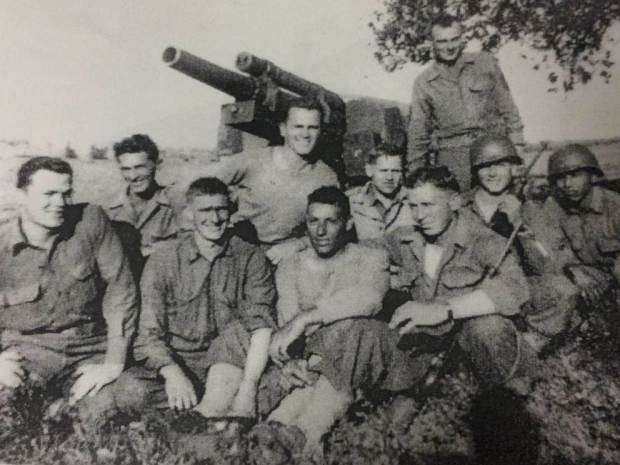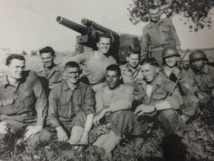Now in Europe for the first time, the collection reveals an unexpected bright side to the Hungarian-born frontline correspondent.
From the French beaches of Biarritz to movie stars like Humphrey Bogart and Ingrid Bergman, the vibrant photos stand in stark contrast to Capa's world-famous shots of the Spanish civil war in the 1930s or the D-Day landings in Normandy a decade later.
They demonstrate that he was ahead of his time and "always tried to find a new way to express himself", said Istvan Viragvolgyi of the Robert Capa Contemporary Photo Center in Budapest.
When US company Kodak released its Kodachrome colour film in 1936, editors dismissed the new technology as of inferior aesthetic value, only good for advertising.
But Capa -- who co-founded Magnum, the world's first cooperative agency for freelance photographers -- recognised colour's potential and became an "early adopter", Viragvolgyi told AFP.
Having made his name as a daring war correspondent, Capa -- who was born Endre Erno Friedmann -- packed rolls of colour film in his luggage for a 1938 assignment in China covering the Second Sino-Japanese war.
"He wanted to experiment on location, not in his backyard at home," Viragvolgyi noted.
- 'Colour is indigestible' -
But Capa's efforts failed to convince editors who continued to pick his black-and-white images.
"They said: 'We don't want the colour pictures because they are not high-value enough for our topics," Viragvolgyi explained.
The new film was also expensive, and had to be sent back to Kodak in the US for developing, a process too time-consuming for most newsrooms.
This resistance to colour persisted even in Capa's closest circles, with fellow Magnum legend Henri Cartier-Bresson once declaring: "Photography in colour? It is something indigestible, the negation of all photography's three-dimensional values."
Undaunted, Capa developed his skills by deliberately using colour effects, often adding rich blues as backgrounds.
"He could sense where colour might add to a picture," said Viragvolgyi.
A 1943 image on display in Budapest shows the French Camel Corps riding to battle in the Tunisian desert against a vivid blue sky backdrop.
"If this was in black-and-white it would be quite dull," explained Viragvolgyi."
"The colour enhances rather than distracts as colour can do sometimes -- one reason why it was often seen as inferior to black-and-white."
Another picture shows men on a tree in Fez, Morocco, waiting for the Sultan to appear at a ceremony.
"It's a simple picture, like a black-and-white, but without the green of the foliage it would lose its spirit," Viragvolgyi said.
- Fighting frustration -
From 1947 onwards, Capa almost always worked with two cameras, one loaded with black-and-white film, one with colour.
Pitching ideas to post-war leisure and travel magazines, he persuaded editors to let him photograph celebrities like Humphrey Bogart, Orson Welles, and Ingrid Bergman at ski resorts or on movie shoots.
To his great frustration, the magazines often still only used the black-and-white versions, however.
The Budapest exhibition reveals colour prints of Pablo Picasso at the seaside and of the US writer Ernest Hemingway on a family hunting trip -- neither of which were ever published.
A letter on display also shows Capa's annoyance with magazines, which he urged to move with the times and use more colour. But his pleas fell on deaf ears.
Capa died in 1954 at the age of 40 after stepping on a landmine while he was covering the war in Vietnam, then called Indochina, for Life magazine.
It would take at least two more decades before colour photography entered mainstream news.
The delay in showing Capa's own colour collection can be partly explained through the fact that many of the images needed to be digitally restored, a painstaking process.
"The miracle of Capa is how he kept on reinventing himself," observed Viragvolgyi.
"You have to go out and try new ways to engage, see the opportunities and take your chances, just as he did."
On display in Budapest until September 20, the show will then head to France.
-----------------------------------------------------------------------------------------------------------------------------------
From the French beaches of Biarritz to movie stars like Humphrey Bogart and Ingrid Bergman, the vibrant photos stand in stark contrast to Capa's world-famous shots of the Spanish civil war in the 1930s or the D-Day landings in Normandy a decade later.
They demonstrate that he was ahead of his time and "always tried to find a new way to express himself", said Istvan Viragvolgyi of the Robert Capa Contemporary Photo Center in Budapest.
When US company Kodak released its Kodachrome colour film in 1936, editors dismissed the new technology as of inferior aesthetic value, only good for advertising.
But Capa -- who co-founded Magnum, the world's first cooperative agency for freelance photographers -- recognised colour's potential and became an "early adopter", Viragvolgyi told AFP.
Having made his name as a daring war correspondent, Capa -- who was born Endre Erno Friedmann -- packed rolls of colour film in his luggage for a 1938 assignment in China covering the Second Sino-Japanese war.
"He wanted to experiment on location, not in his backyard at home," Viragvolgyi noted.
- 'Colour is indigestible' -
But Capa's efforts failed to convince editors who continued to pick his black-and-white images.
"They said: 'We don't want the colour pictures because they are not high-value enough for our topics," Viragvolgyi explained.
The new film was also expensive, and had to be sent back to Kodak in the US for developing, a process too time-consuming for most newsrooms.
This resistance to colour persisted even in Capa's closest circles, with fellow Magnum legend Henri Cartier-Bresson once declaring: "Photography in colour? It is something indigestible, the negation of all photography's three-dimensional values."
Undaunted, Capa developed his skills by deliberately using colour effects, often adding rich blues as backgrounds.
"He could sense where colour might add to a picture," said Viragvolgyi.
A 1943 image on display in Budapest shows the French Camel Corps riding to battle in the Tunisian desert against a vivid blue sky backdrop.
"If this was in black-and-white it would be quite dull," explained Viragvolgyi."
"The colour enhances rather than distracts as colour can do sometimes -- one reason why it was often seen as inferior to black-and-white."
Another picture shows men on a tree in Fez, Morocco, waiting for the Sultan to appear at a ceremony.
"It's a simple picture, like a black-and-white, but without the green of the foliage it would lose its spirit," Viragvolgyi said.
- Fighting frustration -
From 1947 onwards, Capa almost always worked with two cameras, one loaded with black-and-white film, one with colour.
Pitching ideas to post-war leisure and travel magazines, he persuaded editors to let him photograph celebrities like Humphrey Bogart, Orson Welles, and Ingrid Bergman at ski resorts or on movie shoots.
To his great frustration, the magazines often still only used the black-and-white versions, however.
The Budapest exhibition reveals colour prints of Pablo Picasso at the seaside and of the US writer Ernest Hemingway on a family hunting trip -- neither of which were ever published.
A letter on display also shows Capa's annoyance with magazines, which he urged to move with the times and use more colour. But his pleas fell on deaf ears.
Capa died in 1954 at the age of 40 after stepping on a landmine while he was covering the war in Vietnam, then called Indochina, for Life magazine.
It would take at least two more decades before colour photography entered mainstream news.
The delay in showing Capa's own colour collection can be partly explained through the fact that many of the images needed to be digitally restored, a painstaking process.
"The miracle of Capa is how he kept on reinventing himself," observed Viragvolgyi.
"You have to go out and try new ways to engage, see the opportunities and take your chances, just as he did."
On display in Budapest until September 20, the show will then head to France.
-----------------------------------------------------------------------------------------------------------------------------------









 Home
Home Politics
Politics











